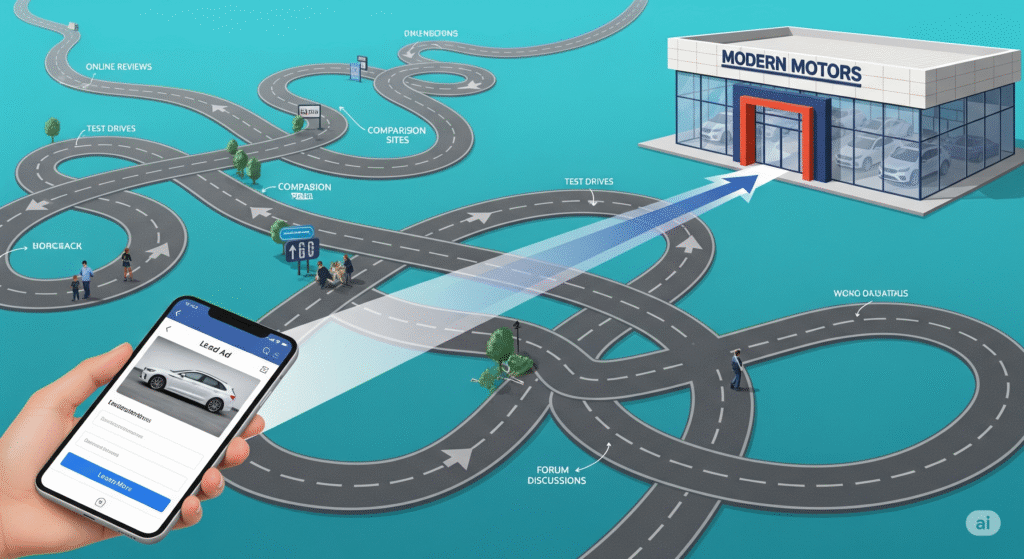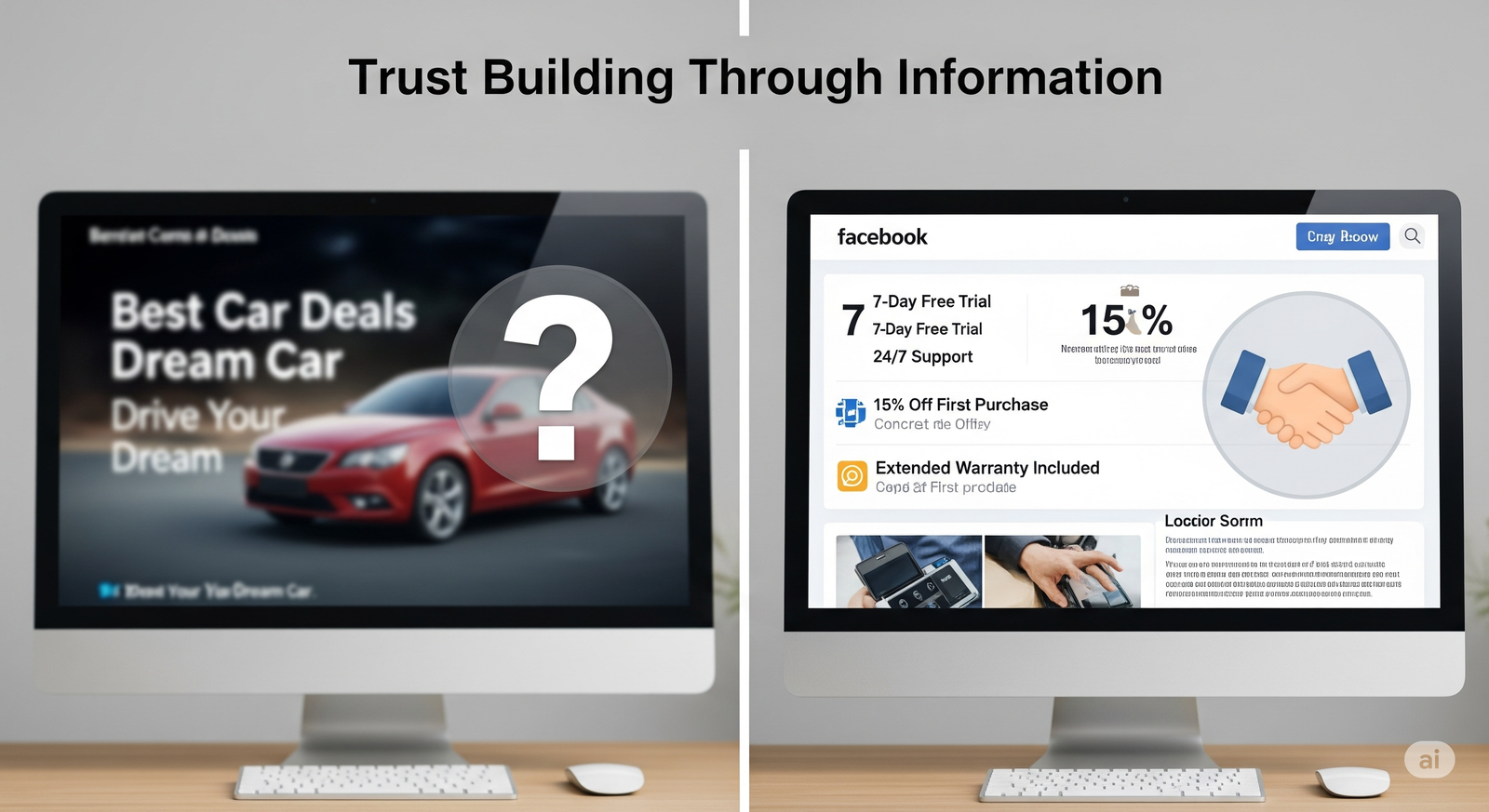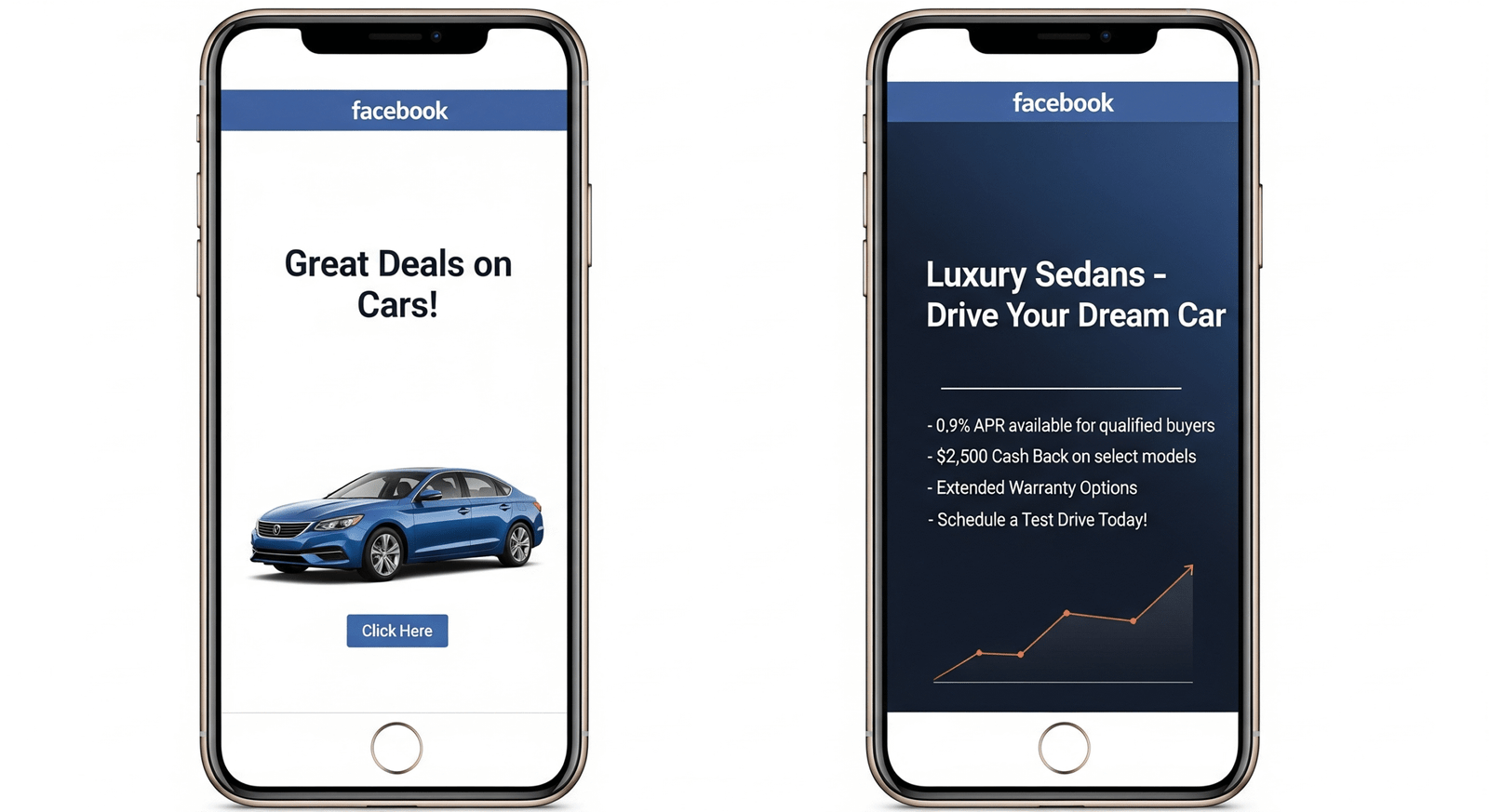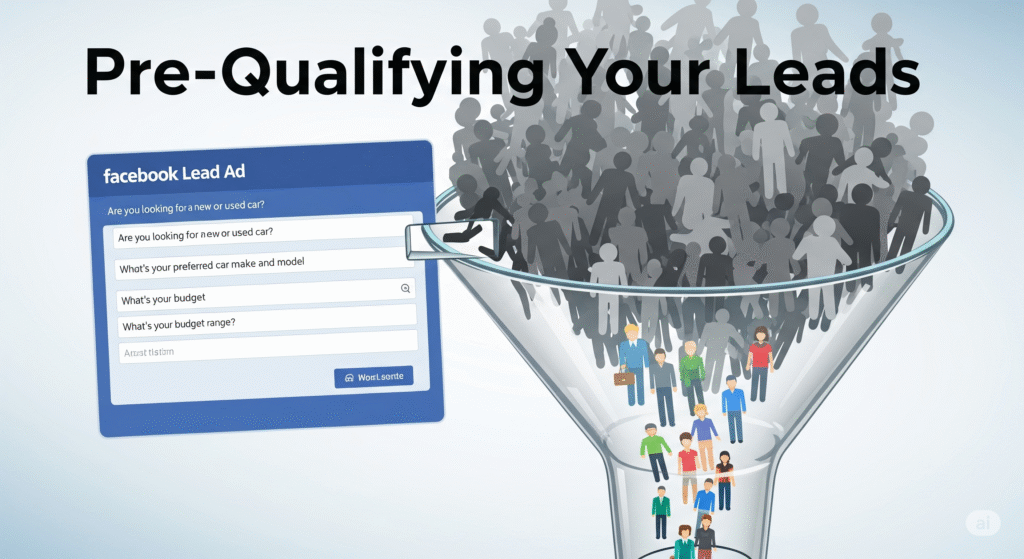When I first started helping automotive dealerships with their Facebook advertising, I made the same mistake most marketers make: I assumed shorter was always better. “Keep it snappy,” I’d tell my clients. “People have short attention spans on social media.”
Boy, was I wrong.
After analyzing thousands of Facebook lead ads across dozens of automotive dealerships, I’ve discovered something that completely changed how I approach ad copywriting for car dealers. The data doesn’t lie: lengthy ad copy featuring finance offers, dealer incentives, and local differentiators can significantly increase click-through rates and engagement, sometimes by as much as 300%.
But here’s the kicker: it’s not just about going long for the sake of it. There’s a science to crafting effective automotive Facebook ad copy, whether you choose the long-form or short-form approach. Today, I’m going to share everything I’ve learned about optimizing Facebook lead ad copy for automotive dealerships, including when to use each strategy and how to maximize your results.
Understanding the Automotive Customer Journey on Facebook

Before we dive into copy strategies, let me paint you a picture of your typical automotive customer scrolling through Facebook. They’re not actively shopping for a car; they’re checking out their friend’s vacation photos, watching cooking videos, or reading news articles. Then suddenly, your ad appears.
This is what we call “interruption marketing,” and it’s fundamentally different from search marketing, where people are actively looking for solutions. Your Facebook ad needs to stop the scroll, capture attention, and create enough interest to generate a lead, all while someone is in a completely different mindset.
The automotive purchase is also one of the most significant financial decisions people make after buying a home. The average car buyer does 14 hours of research before stepping foot on a dealership lot. They’re looking for information, reassurance, and reasons to trust you over your competitors.
This context is crucial because it explains why detailed, informative ad copy often outperforms short, punchy messages in the automotive space. When someone is considering a $30,000+ purchase, they want details, not clever one-liners.
The Case for Long-Form Facebook Ad Copy in Automotive
Let me share a real example from one of my dealership clients. They were running a short-form ad that simply said: “New Honda Accord – Great Deals Available! Click to Learn More.” The ad was getting a 1.2% click-through rate, and the cost per lead was sitting at $47.
I convinced them to test a longer version that included specific financing terms, current incentives, and local differentiators. The new ad was nearly 200 words long and covered:
- Specific APR offers (0.9% for qualified buyers)
- Manufacturer rebates ($2,500 cash back)
- Their unique value propositions (family-owned for 30 years, highest customer satisfaction scores in the county)
- Urgency elements (limited-time offer, ending soon)
The results? Click-through rate jumped to 3.8%, and cost per lead dropped to $29. The longer ad didn’t just perform better – it dominated.
Why Long-Form Works for Automotive Facebook Ads
Trust Building Through Information
Car buyers are skeptical, and rightfully so. The automotive industry hasn’t always had the best reputation for transparency. When you provide detailed information upfront – specific pricing, financing terms, warranties, and incentives – you’re demonstrating transparency and building trust before the prospect even clicks.
Pre-Qualifying Your Leads
Longer ad copy acts as a natural filter. People who read through your detailed offer and still click are more qualified leads. They understand your pricing, know what incentives are available, and have a clearer picture of what to expect. This means higher-quality leads and better conversion rates on your lot.
Standing Out in a Crowded Feed
Most automotive Facebook ads are generic and short. When your ad provides substantial value through detailed information, it stands out. People stop scrolling because they’re getting real, useful information right in their feed.
Leveraging Facebook’s Algorithm
Facebook’s algorithm favors engagement, and longer ads that provide value tend to generate more comments, shares, and meaningful interactions. This increased engagement signals to Facebook that your ad is valuable content, leading to better reach and lower costs.
Essential Elements of High-Converting Long-Form Automotive Ads

Specific Financial Offers
Vague statements like “great financing available” don’t cut it. Your prospects want to know exactly what they can expect. Include:
- Specific APR rates for different credit tiers
- Down payment requirements
- Monthly payment examples for popular models
- Lease terms and mileage allowances
- Any special financing programs (first-time buyer, military, etc.)
Manufacturer and Dealer Incentives
This is where you can really differentiate yourself. Many consumers don’t know about all available incentives, so listing them provides immediate value:
- Cash rebates and their expiration dates
- Trade-in bonuses
- Loyalty discounts for returning customers
- Regional incentives that may not be widely advertised
Local Differentiators
This is your chance to explain why someone should choose your dealership over the competitor down the street:
- Years in business and family ownership
- Customer satisfaction scores and awards
- Service department capabilities and warranties
- Community involvement and local partnerships
- Unique services (free loaner cars, pickup/delivery, etc.)
Social Proof and Credibility Indicators
People want to know others have had positive experiences with your dealership:
- Customer review highlights
- Industry awards and certifications
- Sales volume achievements
- Manufacturer recognition
The Strategic Case for Short-Form Copy
Now, before you think I’m completely anti-short-form copy, let me clarify: there are absolutely times when shorter ad copy makes more sense for automotive dealerships.
When Short-Form Works Best
Brand Awareness Campaigns
If you’re running top-of-funnel campaigns focused on building brand recognition rather than immediate lead generation, shorter copy can be more effective. The goal isn’t to provide all the details – it’s to get your name and basic value proposition in front of potential customers.
Retargeting Warm Audiences
People who have already visited your website, engaged with your previous ads, or are on your email list don’t need as much information. They’re already familiar with your dealership, so shorter, more direct copy can work well for this audience.
Mobile-First Campaigns
While mobile users can and do read longer content, there are situations where shorter copy performs better on mobile devices, particularly for certain demographics or during specific times of day when attention spans are shorter.
Video and Visual-Heavy Ads
When your primary message is delivered through video content or compelling visuals, your text can be shorter and serve as a complement to the visual storytelling rather than carrying the entire message.
Optimizing Short-Form Copy for Maximum Impact
Lead with Your Strongest Differentiator
You don’t have much space, so make every word count. What’s the one thing that sets you apart from every other dealership in your area? Lead with that.
Include Specific Numbers
Even in short copy, specific numbers perform better than vague promises. “$199/month lease deals” outperforms “great lease deals” every time.
Create Urgency
Limited-time offers, limited inventory, or seasonal promotions can create the urgency needed to drive immediate action with fewer words.
Focus on Emotional Triggers
Short copy needs to hit emotional triggers quickly. Words like “finally,” “exclusive,” “limited,” and “guaranteed” can create emotional responses that drive action.
A/B Testing Your Way to Ad Copy Success

Here’s the truth: what works for one dealership might not work for another. Your local market, target demographics, brand positioning, and competition all influence which approach will be most effective for your specific situation.
I always recommend running systematic A/B tests to find your optimal copy strategy. Here’s how I approach it:
Setting Up Meaningful Tests
Test One Variable at a Time
Don’t test long-form versus short-form while also testing different offers or audiences. Keep everything else constant so you can attribute performance differences to copy length.
Ensure Statistical Significance
Run your tests long enough to gather meaningful data. I typically recommend at least 1,000 impressions per ad variation and running tests for a minimum of 7 days to account for day-of-week variations.
Track the Right Metrics
Click-through rate is important, but don’t stop there. Track cost per lead, lead quality scores, and ultimately, which ads drive the most actual sales on your lot.
Advanced Testing Strategies
Sequential Testing
Once you’ve identified whether long-form or short-form works better for your audience, dive deeper. Test different elements within your winning format: various offers, different social proof elements, and alternative urgency tactics.
Audience-Specific Copy
Consider testing different copy approaches for different audience segments. Your remarketing audiences might respond better to short-form copy, while cold audiences might need more detailed information.
Seasonal Adjustments
Copy that works during slow seasons might not be optimal during peak buying times. Test seasonal variations to maximize performance year-round.
Platform-Specific Optimization Techniques
Facebook’s ad platform offers numerous features that can enhance your copy’s effectiveness, regardless of whether you choose long-form or short-form approaches.
Leveraging Facebook’s Native Features
Lead Form Integration
Your ad copy should seamlessly connect with your lead form fields. If your ad mentions specific vehicles or offers, make sure your lead form captures that information to enable proper follow-up.
Dynamic Content
Use Facebook’s dynamic ad features to automatically customize copy based on user behavior, location, or interests. This allows you to maintain personalization even with longer copy formats.
Call-to-Action Optimization
The CTA button you choose can significantly impact performance. “Learn More” might work better for longer, informational copy, while “Get Quote” could be more effective for shorter, offer-focused ads.
Mobile Optimization Considerations
Readability on Small Screens
Even with long-form copy, ensure your text is easy to read on mobile devices. Use short paragraphs, bullet points where appropriate, and avoid overly complex sentences.
Thumb-Stopping Visuals
Your copy needs to work in harmony with your visuals. A compelling image or video can make people more likely to read longer copy, while the right copy can enhance the impact of your visuals.
Industry-Specific Copy Strategies
Different segments within the automotive industry may require different approaches to Facebook ad copy optimization.
New Car Dealerships
New car dealers have the advantage of manufacturer support, current model information, and factory incentives. Your copy should emphasize:
- Latest model features and technology
- Manufacturer warranties and support
- Factory incentives and rebates
- Certified sales and service capabilities
Used Car Dealerships
Used car lots face different challenges, primarily around trust and vehicle history. Effective copy should address:
- Vehicle inspection processes and warranties
- Transparent pricing and history reporting
- Financing options for various credit situations
- Quality guarantees and return policies
Luxury Automotive
Luxury automotive advertising requires a different approach entirely. Copy should focus on:
- Exclusive ownership experience
- Premium service offerings
- Heritage and craftsmanship
- Personalization and customization options
Measuring Success and ROI

Creating great ad copy is only half the battle. You need to measure what matters and continuously optimize based on real performance data.
Key Performance Indicators
Primary Metrics
- Cost per lead (CPL)
- Lead quality scores
- Conversion rate from lead to appointment
- Conversion rate from appointment to sale
- Return on ad spend (ROAS)
Secondary Metrics
- Click-through rate (CTR)
- Cost per click (CPC)
- Engagement rate (likes, comments, shares)
- Reach and frequency
- Brand awareness lift
Attribution and Tracking
Multi-Touch Attribution
Car buyers typically interact with your brand multiple times before making a purchase. Implement tracking systems that can attribute sales to the appropriate touchpoints, including your Facebook ads.
CRM Integration
Connect your Facebook lead data directly to your CRM system to track the complete customer journey from ad click to vehicle delivery.
Lifetime Value Considerations
Don’t just measure immediate sales. Consider the lifetime value of customers, including service revenue, future vehicle purchases, and referrals.
Common Mistakes to Avoid
After working with hundreds of automotive dealerships, I’ve seen the same mistakes repeated over and over. Here are the biggest pitfalls to avoid:
Generic, Template-Based Copy
Every dealership thinks they’re different, but most use the same generic ad copy templates. Your copy should reflect your unique value proposition and local market characteristics.
Ignoring Local Competition
Your ad copy exists in the context of your local market. If every other dealership is advertising 0% financing, leading with that offer won’t differentiate you. Find what makes you unique in your specific market.
Overcomplicating Offers
Complex offers with multiple conditions and exceptions confuse prospects and reduce conversion rates. Keep your offers clear and easy to understand, even in long-form copy.
Neglecting Mobile Experience
Over 80% of Facebook users access the platform primarily through mobile devices. Copy that works great on a desktop might be ineffective on mobile if it’s not properly optimized.
Failing to Update Copy Regularly
Stale ad copy leads to ad fatigue and declining performance. Refresh your copy regularly, even if just to update incentives or seasonal messaging.
The Future of Automotive Facebook Advertising
As we look ahead, several trends are shaping the future of automotive Facebook advertising and copy optimization:
Increased Personalization
Facebook’s targeting capabilities continue to evolve, allowing for more personalized ad experiences. Copy that adapts to individual user preferences and behaviors will become increasingly important.
Video Integration
Video content continues to dominate social media engagement. Learning to integrate compelling copy with video storytelling will be crucial for automotive advertisers.
Privacy-First Advertising
With increasing privacy regulations and changes to tracking capabilities, first-party data and permission-based marketing will become more important. Copy that builds trust and encourages opt-ins will be essential.
AI and Automation
Artificial intelligence tools for copy generation and optimization are becoming more sophisticated. However, the human touch – understanding local markets, customer psychology, and brand voice – remains irreplaceable.
Conclusion and Action Steps
After years of testing and optimizing Facebook ad copy for automotive dealerships, I’ve learned that there’s no universal answer to the long-form versus short-form debate. The best approach depends on your specific situation, audience, and goals.
However, the data consistently shows that detailed, informative copy that includes specific financial offers, incentives, and local differentiators tends to outperform generic, short copy in the automotive space. This makes sense when you consider the high-involvement nature of vehicle purchases and the research-heavy behavior of car buyers.
Here’s what I recommend you do next:
Start with a comprehensive audit of your current Facebook ad copy. Look at your top-performing ads and identify common elements. Are they long or short? What specific elements drive the best results?
Implement a systematic testing strategy. Don’t just guess what will work – test it. Start with a head-to-head comparison of your best short-form ad against a detailed long-form version with specific offers and local differentiators.
Focus on providing genuine value in your copy. Whether you choose long-form or short-form, make sure every word serves a purpose and provides value to your potential customers.
Keep your local market context in mind. What works in a competitive urban market might not work in a smaller town where relationships and reputation carry more weight.
Measure what matters. Don’t get caught up in vanity metrics. Focus on cost per quality lead and, ultimately, return on ad spend.
The automotive industry is evolving rapidly, and so are customer expectations. The dealerships that succeed on Facebook are those that provide transparent, valuable information that helps customers make informed decisions. Whether you do that in 50 words or 500 words is less important than ensuring every word counts.
Remember, your Facebook ad copy is often the first impression potential customers have of your dealership. Make it count by providing the information they need to take the next step in their vehicle buying journey.
Looking to optimize your automotive Facebook advertising strategy? As a specialist in automotive digital marketing, I help dealerships across the country maximize their Facebook ad performance.
Connect with me to discuss your specific challenges and opportunities.
Useful Resources and Backlinks:
- Facebook Business Manager Setup Guide
- Automotive Industry Facebook Advertising Best Practices
- Lead Generation Strategy Guide for Auto Dealers
- Facebook Ads Manager Tutorial
- Automotive Customer Journey Research
- Digital Marketing Metrics That Matter
- Facebook Ad Copy Testing Framework
- Automotive Industry Trends and Insights
- Local SEO for Car Dealerships
- Customer Reviews and Social Proof Guide
